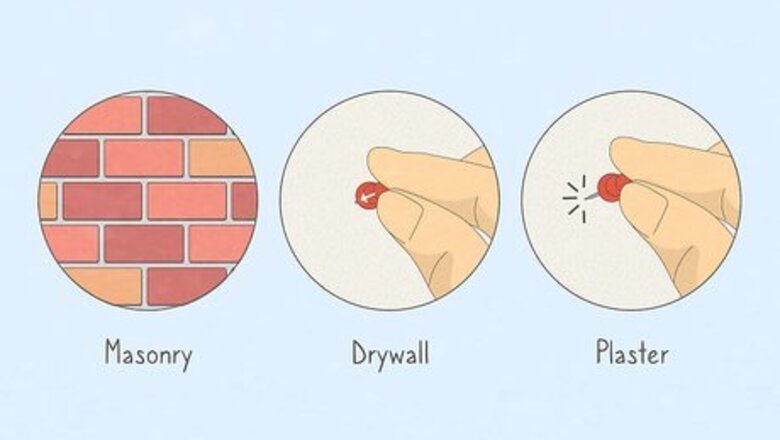
views
Prepping Your Wall and Mirror
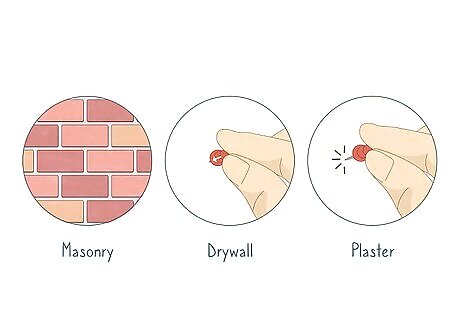
Determine what material your wall is made from. Most walls are made from either drywall, plaster, or masonry. If you have concrete, brick, or tile walls, then they’re made of masonry. If you’re trying to tell the difference between plaster and drywall, stick a push pin into your wall. The pin will easily push into a drywall surface but it’ll take a lot of force to push the pin through plaster. Different wall surfaces require specific hardware or anchors to ensure your mirror doesn’t fall or break. If you use hangers designed for a different material, then they could also damage your walls.

Find and mark the spot where you want your mirror. Hold your mirror up to the wall to see how much space it will take up. Try to find a place that’s about 60–65 inches (150–170 cm) above the floor so your mirror is at eye level. Once you find a good place, ask a friend to mark the edges or corners of your mirror on the wall using a pencil or some painters tape. Check your marks with a level to ensure your mirror hangs straight. If they’re out of line, then adjust the level against your wall until the bubble is in the center of the tube and redraw your marks. If your mirror is too large to hold up easily and mark at the same time, measure it with some measuring tape or a yardstick, and see how those dimensions fit on your wall. EXPERT TIP Peter Salerno Peter Salerno Installation Expert Peter Salerno is the owner of Hook it Up Installation, a professional installation company, which has been hanging art and other objects around Chicago, Illinois for over 10 years. Peter also has over 20 years of experience installing art and other mountable objects in residential, commercial, healthcare and hospitality contexts. Peter Salerno Peter Salerno Installation Expert Expert Trick: If you're hanging a full-length mirror vertically, the best place to put it is 8–12 inches (20–30 cm) off the floor. At this height, you'll be able to see your reflection from head to feet.
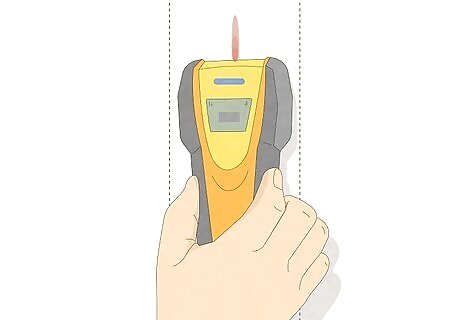
Check drywall and plaster walls for studs using a stud finder. Turn on your stud finder and run it against the wall where you want to install your mirror. When you locate a stud and the finder beeps, use a pencil to mark the location on your wall. If possible, mount your mirror on a stud so it’s the most secure on your wall. If there isn’t a stud right where you want to hang the mirror, that’s okay. You’ll still be able to hang your mirror there, and you’ll just need some extra wall anchors for added support.

Add angle brackets to the mirror's frame if it doesn’t have hardware. Check the back of your mirror to see if it has any pre-installed mounting hardware. If it does, then your mirror is already made to be hung up and has a sturdy frame. If you’re putting an old mirror on the wall and it doesn’t have hardware, then the frame might not support its weight. Place L-shaped angle brackets in each corner of the frame and screw them into the back of your mirror to hold it together. Check your mirror’s warranty if you still have it. Some mirrors are specifically designed to be leaned up against a wall, so if it breaks when you try to hang it, the manufacturer's warranty will not cover the damage. If you’re hanging a frameless mirror, don’t worry about adding any angle brackets.
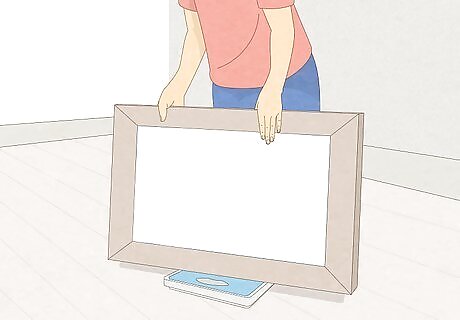
Weigh your mirror on a bathroom scale. Ask a friend to help you lift the mirror and set the edge down on top of your scale. Let go of the mirror and let it lean against you as you read the weight on the scale. Hangers and wall fasteners have specific weight limits, so knowing how heavy your mirror is helps you choose the correct hardware.
Hanging Mirrors with D-Rings or Wire
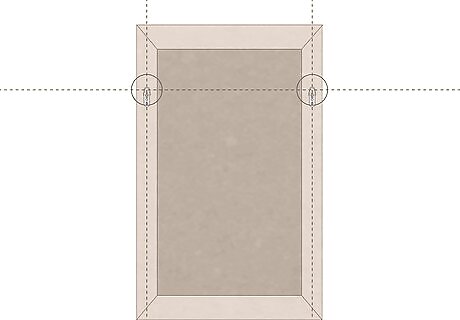
Mark where the tops of the mirror’s hanging hardware lines up on your wall. Your mirror will already have D-rings, which are small metal D-shaped hangers, or it will have picture wire. To hang a mirror with picture wire, pull the center of the wire up until it’s taut. Then, measure the distance from the top of the wire to the frame. If you have D-rings, measure how far apart your fasteners are from one another, and how far they are from the top of the mirror. Transfer the measurements to your markings on the wall so you know where to put the hanger. If you want to be able to make slight adjustments to your mirror’s position after you hang it with picture wire, pull the wire up in 2 places about 12 inches (30 cm) apart. Measure how far the points are from the top and sides of the frame.
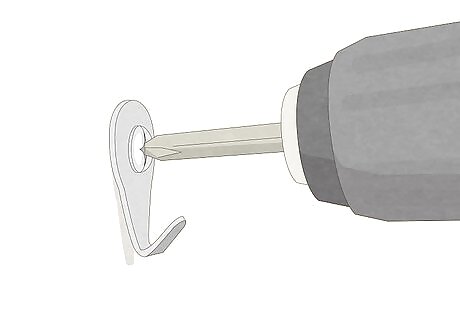
Drill holes and attach wall hooks to your wall. If you’re mounting your mirror directly to a stud, attach the wall hooks 2 ⁄2 in (6.4 cm) wood screws for drywall and 3 in (7.6 cm) screws for plaster walls. If there isn’t a stud or if you have masonry walls, pre-drill holes in your wall and insert wall anchors that are specifically made for the material. Then, just screw the hook directly into the anchor. Use wall hooks that have a weight limit that’s higher than the weight of your mirror. Toggle bolts are a great alternative to wall anchors if you have drywall or plaster. Make a hole large enough for the end of the bolt to fit through. Push the end of the bolt through the hole so the wings open up. Then, just tighten the bolt against the wall to secure it. If you have masonry walls, be sure to use a masonry bit on your drill since wood bits will get dull or damaged.

Put rubber bumpers on the back corners of your mirror. Peel a rubber bumper off of the adhesive backing and press it down firmly in the corner of your mirror. These little pieces will help prevent your mirror from tilting or leaving marks on the wall.

Mount your mirror onto the wall hooks. Line up your rings or wire with the hooks on your wall, and hang the mirror. If your mirror is too heavy or large for you to lift easily, ask a friend or family member to help out. Once you have the mirror hung up, take a step back to check that the mirror is straight. If you need to make any adjustments, carefully reposition the mirror before checking how it looks again.
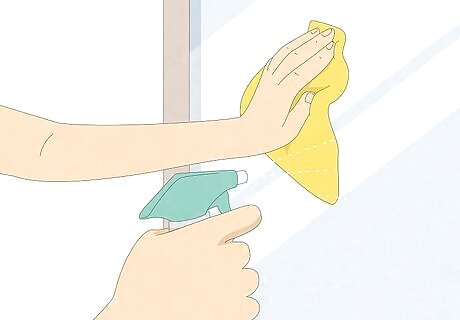
Clean off your mirror with glass cleaner. Now that your mirror is in place, polish or wipe down the surface with a soft microfiber cloth and some glass cleaner so it’s streak-free and reflective..
Using French Cleats
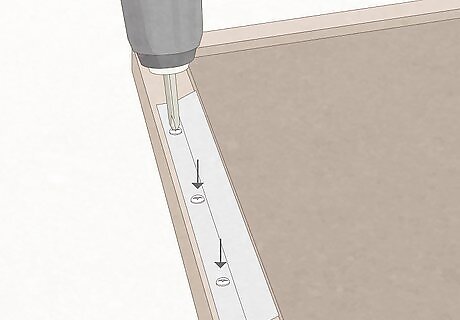
Screw your cleats onto the mirror frame if they’re not already attached. French cleats have a bottom half that attaches to the wall and a top half that attaches to your mirror. If your mirror doesn’t already have the cleats pre-installed, position the mirror-side of the cleats with the downward-facing hooks along the top edge of the mirror. Use screws that are shorter than the frame’s thickness to attach the cleats. Use French cleats that have a weight limit higher than the weight of your mirror. You may only need one cleat for smaller mirrors, or 2–3 if you’re hanging a heavy mirror.

Attach the wall-side cleats to your wall. Measure the distance from the sides of the frame to your cleats, and transfer the measurement onto your wall. Use a level to ensure your marks line up. Once you have them level, position the wall-side of the cleats with upward-facing hooks on your wall to mark the screw holes. Pre-drill holes that are a size smaller than your screws to avoid wall damage. Then, hold your cleats against the wall and screw them in. If you’re screwing into a stud, then use 2 ⁄2 in (6.4 cm) wood screws for drywall and 3 in (7.6 cm) screws for plaster. If you’re attaching the cleat through drywall or plaster without a stud, put a wall anchor or toggle bolt into the hole first. Then attach your cleat with the provided screws. If you are hanging the mirror on a brick or concrete wall, install a masonry wall anchor in the hole before putting screws in.
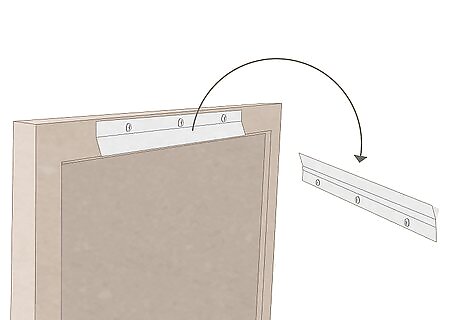
Hang the mirror from the wall cleats. Have a helper assist you when you lift your mirror so it’s easier to maneuver. Line up the cleats on the back of the mirror with the ones on the wall, and slowly lower your mirror down onto them. Push the mirror slightly to the left or right to slightly adjust its position. Just be sure not to slide the mirror off of the cleats. After you hang your mirror, wipe it off with glass cleaner to get rid of any fingerprints or streaks.
Hanging Frameless Mirrors with Adhesive
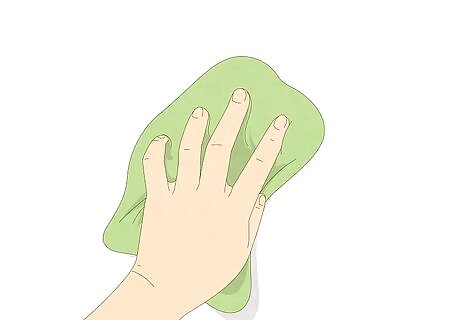
Wipe the wall with a damp cloth. Wet a clean cloth with warm water and run it over your wall where you plan on hanging the mirror. Keep wiping the surface until you don’t see anymore dirt or dust lift up. If you don’t wipe your wall off, then the adhesive you used won’t make a good connection.
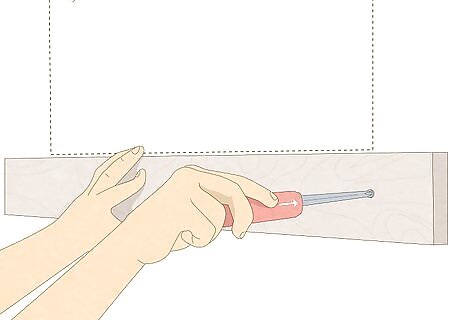
Attach a temporary horizontal wood support to your wall. Get a 2 in × 4 in (5.1 cm × 10.2 cm) board that’s the same length or slightly longer than your mirror. Screw the support into your wall every 8–12 inches (200–300 mm) so it doesn’t move around or shift once you set the mirror on top of it. Because the adhesive needs time to cure, the temporary support holds your mirror in place so it doesn’t fall down. If the bottom of the mirror is against the top of a vanity, then you don’t need to use a support board.
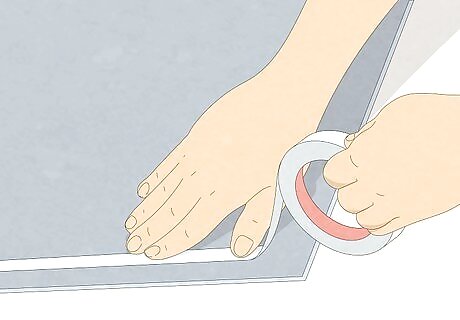
Apply adhesive or mirror tape on the back of your mirror. Use an adhesive glue or tape that’s specifically made for mirrors to ensure it doesn’t fall down. Place the adhesive in vertical strips every 2–3 inches (5.1–7.6 cm) along the length of the mirror. If you’re using adhesive tape, apply about 12 inches (30 cm) for every 4 ⁄2 pounds (2.0 kg) that your mirror weighs. Use adhesive or tape that matches the weight of your mirror. Since adhesives are the weakest hanging product, only use them with lightweight mirrors instead of large, heavy ones. Avoid placing adhesive horizontally since condensation could get trapped behind your mirror and cause water damage to your walls.

Push the mirror firmly against your wall. Ask a friend to help you lift your mirror, especially if it’s large or heavy. Line up the mirror with the marks you made on your wall and slowly press the mirror against it. Hold the mirror in place according to the instructions on the adhesive, which should take about a minute or two. After that, let go of the mirror so the bottom is resting on the support board. Make sure the mirror is exactly where you want it since it will be very difficult to remove and replace after the adhesive dries.
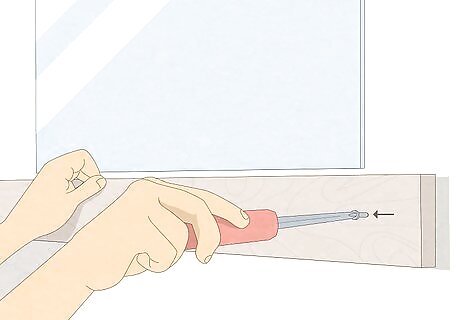
Remove the support in 1–2 days after the adhesive cures. Even if the adhesive looks dry within a few minutes, it needs time to fully harden and cure. While it usually takes 1–2 days, leave the support board attached to your wall for the cure time listed on the adhesive’s packaging. After that, use a screwdriver to remove the board. Clean off your mirror with glass cleaner and a soft microfiber cloth after it’s fully installed. After you take off the support board, repair the holes in your wall using some spackle.















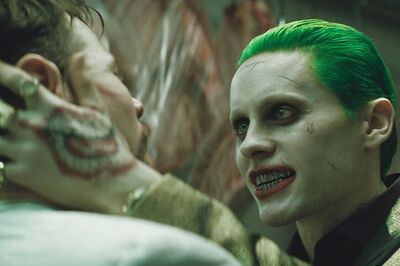
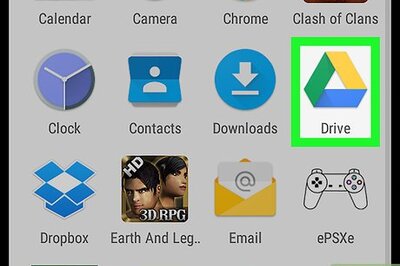

Comments
0 comment